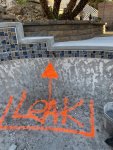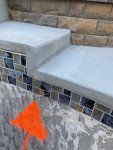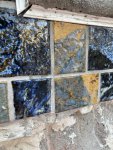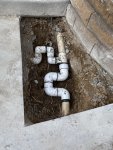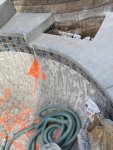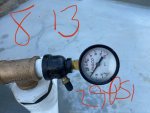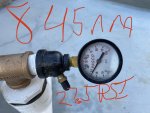The pool failed a pressure test AFTER concrete deck and coping was poured. Should the tile in front of the leak be replaced to? They believe plumbing was spiked when the forms were placed. What can I expect the effort to be? Thank you!
Failed pressure test
- Thread starter Howard 702
- Start date
You are using an out of date browser. It may not display this or other websites correctly.
You should upgrade or use an alternative browser.
You should upgrade or use an alternative browser.
- Jul 21, 2013
- 53,451
- Pool Size
- 35000
- Surface
- Plaster
- Chlorine
- Salt Water Generator
- SWG Type
- Pentair Intellichlor IC-60
One trade damaging another trades work is why the pressure test should be maintained until all construction is complete. Be glad that they found it at this stage.
The effort depends where the pipe trench runs and exactly where the leak is found. They need to go digging and see. You will know better what needs to be rebuilt after they find the leak.
Do you have pics of that area when it is all opened up to see where the pipes run?
The effort depends where the pipe trench runs and exactly where the leak is found. They need to go digging and see. You will know better what needs to be rebuilt after they find the leak.
Do you have pics of that area when it is all opened up to see where the pipes run?
- Nov 12, 2017
- 11,933
- Pool Size
- 12300
- Surface
- Plaster
- Chlorine
- Salt Water Generator
- SWG Type
- Pentair Intellichlor IC-40
Is the leak coming out of the tile, above the bottom of the tile? Or coming out right at the bottom of the tile, or below? Gunite isn't water proof. The tile and mortar and grout should be. So if it's just leaking right at the intersection of the tile and the gunite, then that might be OK. That will get sealed up when they shoot the plaster finish.
That leak arrow indicates where water is escaping, not necessarily where it is coming from. If the defect is not under the deck, which is possible, then it's just a matter of digging up the pipes and finding/fixing the leak. Hopefully it's just a failed glue joint in one of the pipes. But if the leak is under the deck, then you might be looking at demo'ing some of the new concrete to get at it. That may or may not compromise the tile. I wouldn't expect the tile damage to be extensive. But if the leak is under the deck, fixing the tile is the least of the problem, and expense. If the deck has rebar in it, and the exact location of the leak is hard to determine, then they'll have to keep removing concrete and digging under it until the leak is found.
There are systems that can "fix" a leak in an underground pipe without digging anything up, but I'm not sure how well they work, and they're not cheap. I'm not sure I would accept such a repair, because what happens if it fails after your warranty expires? As distasteful as it would be, it's probably better to find the leak and fix it right (which means digging it up). But if you want some options:
You can google "fix leak in underground pool plumbing - Google Search"
Here's one solution:

 www.pipefuze.com
www.pipefuze.com
That leak arrow indicates where water is escaping, not necessarily where it is coming from. If the defect is not under the deck, which is possible, then it's just a matter of digging up the pipes and finding/fixing the leak. Hopefully it's just a failed glue joint in one of the pipes. But if the leak is under the deck, then you might be looking at demo'ing some of the new concrete to get at it. That may or may not compromise the tile. I wouldn't expect the tile damage to be extensive. But if the leak is under the deck, fixing the tile is the least of the problem, and expense. If the deck has rebar in it, and the exact location of the leak is hard to determine, then they'll have to keep removing concrete and digging under it until the leak is found.
There are systems that can "fix" a leak in an underground pipe without digging anything up, but I'm not sure how well they work, and they're not cheap. I'm not sure I would accept such a repair, because what happens if it fails after your warranty expires? As distasteful as it would be, it's probably better to find the leak and fix it right (which means digging it up). But if you want some options:
You can google "fix leak in underground pool plumbing - Google Search"
Here's one solution:

PipeFuze
PipeFuze is a polymer based pipe injection system designed to repair plumbing lines without the hassle of cutting through concrete or digging up the line.
Thank you, they are supposed to asses the situation today. I suspect the leak is under the deck and the water is being pushed that direction. I will keep you all posted thanks for the quick respones!
I do not have pictures since it was a remodel and that side of the pool wasn’t impacted. We did have to dig on the other side for two sheets that we’re going in and found the existing pipe only down about 8”. So we laid in the new pipe 18”.One trade damaging another trades work is why the pressure test should be maintained until all construction is complete. Be glad that they found it at this stage.
The effort depends where the pipe trench runs and exactly where the leak is found. They need to go digging and see. You will know better what needs to be rebuilt after they find the leak.
Do you have pics of that area when it is all opened up to see where the pipes run?
- Jul 21, 2013
- 53,451
- Pool Size
- 35000
- Surface
- Plaster
- Chlorine
- Salt Water Generator
- SWG Type
- Pentair Intellichlor IC-60
found the existing pipe only down about 8”.
That should have been a warning to all the trades working to be careful. Not that they care. It ends up being your problem, not theirs.
- Nov 12, 2017
- 11,933
- Pool Size
- 12300
- Surface
- Plaster
- Chlorine
- Salt Water Generator
- SWG Type
- Pentair Intellichlor IC-40
That's a bad spot for a leak at this point. Very hard to repair amd not look patched. They should have kept it pressurized during the work. Hope its accessible amd it works out in your favor
- Nov 12, 2017
- 11,933
- Pool Size
- 12300
- Surface
- Plaster
- Chlorine
- Salt Water Generator
- SWG Type
- Pentair Intellichlor IC-40
Yay!! Not ideal, of course, but that could have been way worse. Whew!! There were TWO leaks!?! Yikes. OK, back to your regularly scheduled programming! 

- Nov 12, 2017
- 11,933
- Pool Size
- 12300
- Surface
- Plaster
- Chlorine
- Salt Water Generator
- SWG Type
- Pentair Intellichlor IC-40
The test is done with air. As it changes in temperature, it'll increase/decrease pressure. That said, you'd think the pressure would rise as the day heats up. Monitor it regularly throughout the day. If it fluctuates up and down, that's fine. If it only drops, that's bad.
- Nov 12, 2017
- 11,933
- Pool Size
- 12300
- Surface
- Plaster
- Chlorine
- Salt Water Generator
- SWG Type
- Pentair Intellichlor IC-40
Oh, if you checked 30 minutes immediately after it was pressurized, a drop would be expected. Pressurized air heats up, in the compressor and in the pipe. As it cools in the pipe, the pressure would drop. Just keep an eye on it for the general trend over time.
I know that from my SCUBA diving days. A freshly filled tank is very warm to the touch. A good filling station operator would fill the tank to its rated capacity, then let it cool for a while, then "top it off" back up to its rated capacity. That ensures the user gets a good fill with the max air the tank can hold.
I know that from my SCUBA diving days. A freshly filled tank is very warm to the touch. A good filling station operator would fill the tank to its rated capacity, then let it cool for a while, then "top it off" back up to its rated capacity. That ensures the user gets a good fill with the max air the tank can hold.
Last edited:
sktn77a
Gold Supporter
Thread Status
Hello , This thread has been inactive for over 60 days. New postings here are unlikely to be seen or responded to by other members. For better visibility, consider Starting A New Thread.


